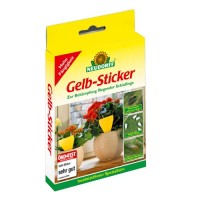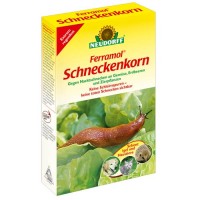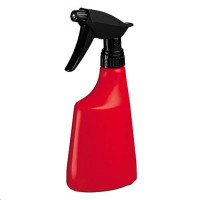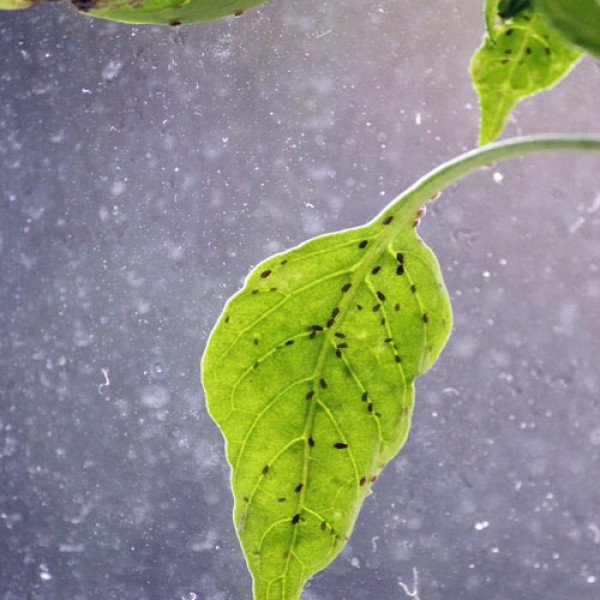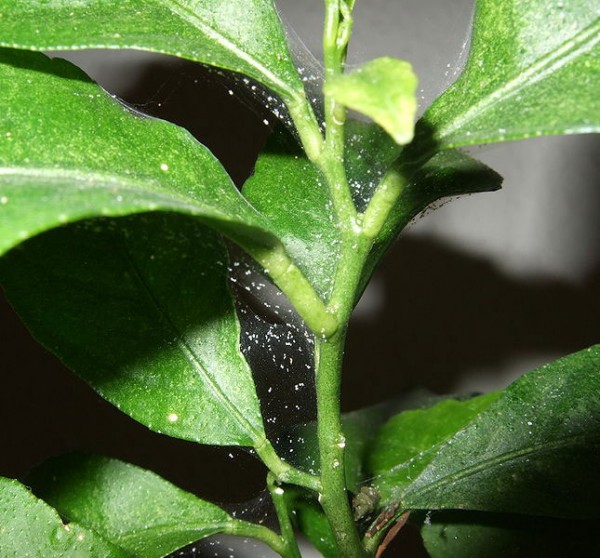Chili pest control
Chili pest control
There are some basics to strengthen your chili plants without having to go to the chemistry club (after all, you want to enjoy your chillies without carcinogenic substances).
It is precisely in the open air that balance can be restored very quickly by supporting the natural giddy enemies. Also pay attention to the fruit sequence in the garden, which means: plant the chili every year in a different bed. Likewise, a mixed culture is favourable: Chillies feel comfortable in the neighborhood of tomatoes, aubergines and herbs with essential oils, e.g. Oregano, basil and rosemary, while fennel does not do them any good. Since there is almost no natural regulation of beneficial organisms within the house, you should react quickly in case of infestation. But also here there are natural pesticides, e.g. Neem oil, neem powder or a variety of insect larvae that gently intervene.
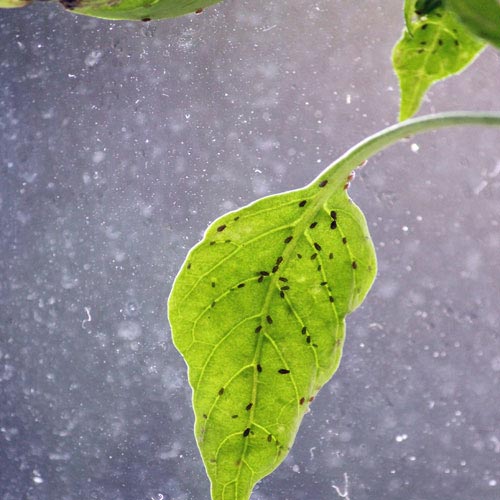 Damage: Aphids suck the plants juice. They usually sit on the leaf bottoms and along the leaf stalks. The leaves and buds are damaged or die. It becomes much worse when the aphids additional transmit viral diseases. The lice can be seen with the naked eye or idetified by sticky drops on the leaves or in the environment (honeydew). There are hundreds of different species, including green, yellow, red and black aphids.
Damage: Aphids suck the plants juice. They usually sit on the leaf bottoms and along the leaf stalks. The leaves and buds are damaged or die. It becomes much worse when the aphids additional transmit viral diseases. The lice can be seen with the naked eye or idetified by sticky drops on the leaves or in the environment (honeydew). There are hundreds of different species, including green, yellow, red and black aphids.
Prevention: In the garden, the ecological balance usually arises quickly. You can help by collecting natural enemies of the aphids and putting them on the plants (ladybugs and their larvae, earworms...). Nettle water is a helpful starch for the plants. Often an aphid pest also occurs when you bring your pots indoors in autumn. Then you should use a pest control, e.g. Neem oil (see below).
Treatment: Robust potted plants can be rinsed with the garden hose or in the bathtub in winter. Neem oil is a natural and very effective remedy for tender young plants or strong infestations. You can get this in the garden center or DIY store, but you should read the package insert / recommendations carefully. They are usually diluted with water and sprayed on the infested plants. Do not dispense with chemical products. If you still want to use them, be sure to follow the instructions!
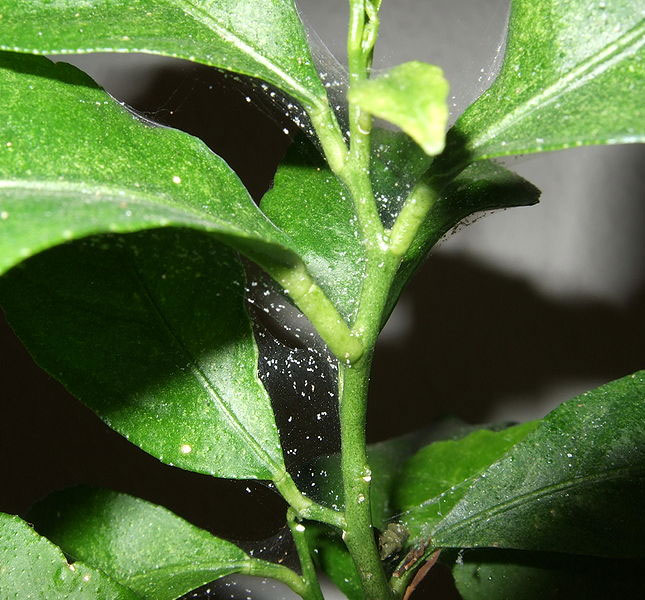 Damage: The spider mites are only 0.5 mm long and like the aphids they suck the plant juice from the leaves, which then get yellow spots on the top of the leaves, later they completely wilt and fall off. The mites usually sit on the underside of the leaves and form a fine web in which the larvae develop. Particularly warm, dry heating air favours their spread.
Damage: The spider mites are only 0.5 mm long and like the aphids they suck the plant juice from the leaves, which then get yellow spots on the top of the leaves, later they completely wilt and fall off. The mites usually sit on the underside of the leaves and form a fine web in which the larvae develop. Particularly warm, dry heating air favours their spread.
Prevention: In the garden, the spider mites are usually kept at bay by their natural enemies (spiders, parasitiy wasps, green lacewings, kissing bugs, and ladybirds). The spider mites can spread very much in greenhouses and on the window sill, especially when it is warm and dry. You can reduce this by spraying your chillies regularly with water.
Treatment: Neem oil can be effective against spider mites. For this purpose, the oil is diluted with water and the broth is applied with a flower spray bottle. You should pay particular attention to the undersides of the leaves. Reapply the neem oil once a week at the minimum. Some gardeners swear by sprinkling of garlic tea. You can also buy the natural enemies like predatory mites (Phytoseiulus persimilis and Amblyseius californicus are particularly active against spider mites).
Image source: Wikipedia, Paramecium
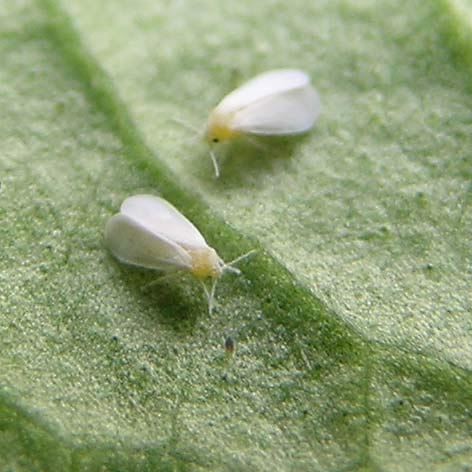 Damage: Originally from Central America, this moth-dandelion has spread throughout Europe with indoor plants. The white larvae and adult flies (about 2mm long) sit at the bottom of the leaves and suck the plant juice. As in the case of the aphids, a sticky layer is visible on the leaves (honeydew) on which molds like to settle. If the plant is shaken, the flies fly in swarms.
Damage: Originally from Central America, this moth-dandelion has spread throughout Europe with indoor plants. The white larvae and adult flies (about 2mm long) sit at the bottom of the leaves and suck the plant juice. As in the case of the aphids, a sticky layer is visible on the leaves (honeydew) on which molds like to settle. If the plant is shaken, the flies fly in swarms.
Prevention: Keeping natural predators around will prevent whiteflies from ever exploding in population. Ladybugs, spiders, lacewing larvae, and dragonflies are a few of many beneficial insects that can control a whitefly population. Immediately at the beginning of infestation, set out yellow sticky traps. The yellow color attracts in particular white flies, winged aphids and dark-winged fungus gnats. They get stuck on the glue surface, so they can then no longer multiply.
Treatment: Moving the plant pots to a cooler place may help, since the white fly only breeds at temperatures above 16° C. As biological pest control, you can spread out ladybugs, spiders, lacewing larvae, and dragonflies. A home remedy is a mixture of soft soap or dishwashing liquid and water (30 g to 1 liter of water). Then, spray your leaves and coat them. After about an hour of exposure, the plant should be showered to prevent the soap from contaminating the substrate. Neem oil has also shown some positive effects.
Image source: Wikipedia, gaucho
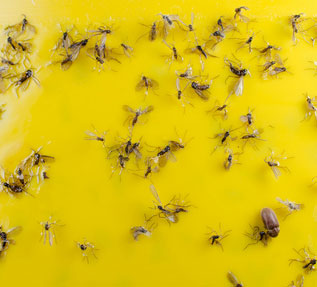 Damage: Dark-winged fungus gnats are small, delicate, dark coloured flies (approx. 2 - 4 mm in size), are a common pest of plants grown indoors, especially when humidity and moisture is high. They`re usually first noticed when the harmless adults are seen flying around house plants or gathered at a nearby window. The white, 1-2 mm long larvae which live in the moist soil can damage tender roots and seedlings. Fungi and viruses can then penetrate the infected sites and cause damage to the plant. Plant symptoms are sudden wilting, poor growth and yellowing.
Damage: Dark-winged fungus gnats are small, delicate, dark coloured flies (approx. 2 - 4 mm in size), are a common pest of plants grown indoors, especially when humidity and moisture is high. They`re usually first noticed when the harmless adults are seen flying around house plants or gathered at a nearby window. The white, 1-2 mm long larvae which live in the moist soil can damage tender roots and seedlings. Fungi and viruses can then penetrate the infected sites and cause damage to the plant. Plant symptoms are sudden wilting, poor growth and yellowing.
Prevention: Use a high-quality, thermally treated earth. Do not overwater plants. Allow the top layer of soil to dry before watering or water the pots only from below. You can also cover the top floor layer with quartz sand. Spreading of garlic tea to the earth may also be helpful. Immediately at the beginning of infestation, set out yellow index cards.
Treatment: Replanting the plant is only worthwhile if really all the earth is removed, because eggs can be left in the earth, and then the life cycle begins anew. Set out yellow stickers as soon as you discover the first gnats. The gnats are attracted by the yellow color, get stuck on the glue surface, and die. This prevents more spreading.
Some swear to put some match-heads in the ground, the sulfur drives out the larvae. It may also be helpful to spray the surface of the earth with garlic tea (for this purpose, crush 3 cloves and boil in ½ liter of water). The Fungus Gnat Predator (Hypoaspis aculeifer) as well as nematodes (Steinernema feltiae nematodes known as SF nematodes) or BTI (Bacillus thuringiensis israelensis) are tiny, but effective killers of fungus gnat and other harmful larvae found in soil. This beneficial insects prowl the soil attacking the larvae and feeding on their contents. If you use the predators in combination with yellow sticky traps, you will get rid of gnats within 2-4 weeks.
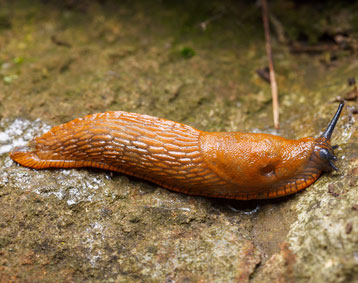 Damage: Slugs and snails like to eat the leaves of vegetable plants and many gardeners have stood in the morning in front of a devoured salad or vegetable patch, where only the skeletons of the plants have been left over. The evildoers are usually certain types of slugs. In contrast, the grapevine snail even eats the eggs of the slugs and helps the gardener more than harms them.
Damage: Slugs and snails like to eat the leaves of vegetable plants and many gardeners have stood in the morning in front of a devoured salad or vegetable patch, where only the skeletons of the plants have been left over. The evildoers are usually certain types of slugs. In contrast, the grapevine snail even eats the eggs of the slugs and helps the gardener more than harms them.
Preventive measures: he simplest method is to collect the slugs in the early morning hours. Slugs and snails generally can not crawl upside down on objects, so snail fences or collars are helpful. These have an outwardly everted edge over which the slugs can not crawl. Of course, this does not help against slugs that are already in the bed, but is a good remedy for potted plants (especially the snail collar). Coffee, lime and sawdust are also effective against snails, but only in dry weather. To do this, sprinkle coffee grounds, lime or sawdust in a 20 cm wide strip around the bed. The snails avoid the powder because it removes moisture and the caffeine in the coffee acts on it as a neurotoxin.
Countermeasures: A well-known method against slugs is the beer trap. The animals are attracted magically by the beer smell, but also the slugs from the neighboring gardens. For a trap, bury a pot half into the ground and half fill it with beer (some gardeners swear by sweeter varieties). Of course, you should remove the drowned and dead corpses daily. Natural predators of the slugs are ducks, hedgehogs, shrews, blind worms, leopard slugs (attention, not to be confused with the slugs!), toads and frogs and also some beetle and spider species eat the eggs of the slugs. Chemical snail & slug control is the so-called slug pellets, which can also be dangerous for humans and animals and must not be used in the kitchen garden. In the organic cultivation iron-III-phosphate is usually used, which, however, kills all snails and slugs, including the useful leopard slug. .
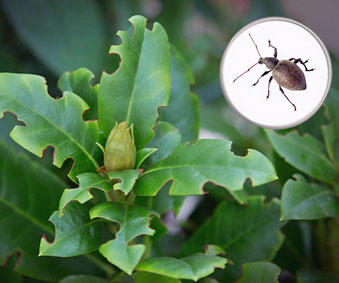 Damage: The weevils or snout beetles eat on leaves, young shoots and buds. They usually eat from the edges of small crescent-shaped bays in the leaves. The larvae make their way (especially in winter) over the plant roots, which leads to wilting spots in the plant. There are about 60,000 different weevil species worldwide, with the most common weevil being the black vine weevil.
Damage: The weevils or snout beetles eat on leaves, young shoots and buds. They usually eat from the edges of small crescent-shaped bays in the leaves. The larvae make their way (especially in winter) over the plant roots, which leads to wilting spots in the plant. There are about 60,000 different weevil species worldwide, with the most common weevil being the black vine weevil.
Preventive measures: Use thermally treated soil.
Countermeasures:If infested with potted plants shake them off best and collect the beetles. Nematodes (of the genus Heterorhabditis - for example, Heterorhabditis bacteriophora) can be used against the weevil larvae. These are commercially available, biologically safe as they only attack the weevil larvae, and they are introduced into the soil with the irrigation water. The nematodes invade the larvae and excrete a bacterium that kills the larvae. The nematodes represent an effective pest control even with large-scale infestation. Another measure against the weevil is the incorporation of 50 g / m² Neem cake (squeezed seeds of the neem tree) in the soil around the plant. The insect-poisoning neem agent is taken up by the plant and the insects cease their feeding activity. But beware: since Neem also works against nematodes, you should not use the two methods at the same time.
Caterpillars (Butterfly Larvae)
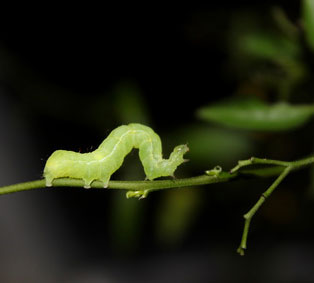 Damage: eaten leaves, young shoots and flowers. Few caterpillars can cause an immense damage in a short time. Often they are very well camouflaged by colour and shape. In the picture you can see the caterpillar of the small winter moth, which occurs relatively frequently in our latitudes. The small green caterpillars are very well camouflaged, very frangible and recognizable by the hump they make when moving.
Damage: eaten leaves, young shoots and flowers. Few caterpillars can cause an immense damage in a short time. Often they are very well camouflaged by colour and shape. In the picture you can see the caterpillar of the small winter moth, which occurs relatively frequently in our latitudes. The small green caterpillars are very well camouflaged, very frangible and recognizable by the hump they make when moving.
Preventive measures: Protect any young seedlings with a cardboard cup (bottomless paper cup), which you insert 2-3 cm deep into the ground.
Countermeasures: Look carefully and collect. Spraying is not recommended for crops. Natural enemies are: bugs, ground beetles, parasitic wasps, spiders and birds.
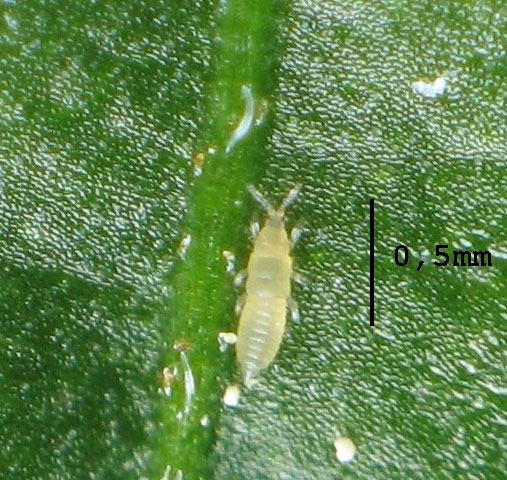 Damage: Thrips are small elongated insects, about 1 - 2 mm long with fringed wings. At first glance, they look like a tiny chopstick. Their larvae resemble tiny bright green or yellowish worms. The adult thrips sting and suckle leaf cells, recognizable by silvery shiny spots and dark traces of feces on the undersides of the leaves. The pests can also transmit viruses and crippling young plants.
Damage: Thrips are small elongated insects, about 1 - 2 mm long with fringed wings. At first glance, they look like a tiny chopstick. Their larvae resemble tiny bright green or yellowish worms. The adult thrips sting and suckle leaf cells, recognizable by silvery shiny spots and dark traces of feces on the undersides of the leaves. The pests can also transmit viruses and crippling young plants.
Preventive measures: dry room air accelerates the spread, therefore frequent airing helps. Use high quality, thermally treated soil.
Countermeasures:Regular showering of the plant, in which case the soil ball should first be packed in a plastic bag in order to reduce re-establishment. Helpful is also the introduction of natural predators such as predatory mites, nematodes or lacewings (commercially available). Treat the leaves with neem oil or plant nourishment from nettle or garlic.
Image source: Wikipedia, M.J.
Manufacturer
Name: | Chili-Food-Wissen |
Address: |
Super hilfreich
Nachdem wir letztes Jahr gar keine Blattläuse hatten, waren wir dieses Jahr umso überraschten, daß es dieses Jahr eine richtige Seuche war. Die Chilis waren in voller Blüte und die gierigen Biester einfach nicht loszuwerden. Die gängigen Hausmittel hatten wir schon durch,aber es wurden immer mehr.
Wir haben es dann mit Neemöl und Neempresskuchen versucht. Leider hat die erste Behandlung die Plage noch nicht stoppen können. Nach der zweiten Spritzbehandlung und nachdem wir zusätzlich den Neempresskuchen in die Erde eingearbeitet hatten, gaben die Blattläuse endlich auf. Die Ernte war großartig!!!
Nächstes Jahr kommt der Neempresskuchen gleich von Anfang an mit in die Erde.
Danke an euren großartigen Tipps und die tollen Chillipflanzen, die wir jedes Jahr von euch bekommen.
Sehr hilfreich
Nachdem ich letztes Jahr mit ungleublich vielen Blattläusen zu kämpfen hatte und diese mir fast sämtliche Knospen ruiniert hatten, bin ich auf der suche nach eine gute Methode um Läuse in Zaum zu halten, ohne mit dem chemischem Hammer einzugreifen. Ich finde die Texte gut und hilfreich gestaltet, vielen Dank dafür
